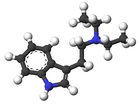Diethyltryptamine
 |
|
 |
|
| Clinical data | |
|---|---|
| ATC code |
|
| Legal status | |
| Legal status |
|
| Identifiers | |
|
|
| CAS Number | |
| PubChem CID | |
| DrugBank | |
| ChemSpider | |
| UNII | |
| ChEMBL | |
| Chemical and physical data | |
| Formula | C14H20N2 |
| Molar mass | 216.32 g/mol |
| 3D model (Jmol) | |
| Melting point | 169 to 171 °C (336 to 340 °F) |
|
|
|
|
|
|
|
DET, also known under its chemical name N,N-diethyltryptamine and as T-9, is a psychedelic drug closely related to DMT and 4-HO-DET. However, despite its structural similarity to DMT, its activity is induced by an oral dose of around 50–100 mg, without the aid of MAO inhibitors, and the effects last for about 2–4 hours.
DET is an analogue of the common tryptamine hallucinogen N,N-Dimethyltryptamine or DMT.
The mechanism of action is thought to be serotonin receptor agonism, much like other classic psychedelics.
DET is sometimes preferred over DMT because it can be taken orally, whereas DMT cannot. This is because the enzyme monoamine oxidase degrades DMT into an inactive compound before it is absorbed. To overcome this, it must be administered in a different manner, i.e. intravenously, intramuscularly, by inhalation, by insufflation, rectally, or ingested along with an inhibitor of monoamine oxidase. Because DET has ethyl groups attached to its nitrogen atom, monoamine oxidase is unable to degrade it. This is also true for many other tryptamines with larger nitrogen substituents.
Although DET is a synthetic compound with no known natural sources, it has been used in conjunction with the mycelium of Psilocybe cubensis to produce the synthetic chemicals 4-PO-DET (Ethocybin) and 4-HO-DET (Ethocin), as opposed to the naturally occurring 4-PO-DMT (Psilocybin) and 4-HO-DMT (Psilocin). Isolation of the alkaloids resulted in 3.3% 4-HO-DET and 0.01-0.8% 4-PO-DET.
...
Wikipedia
